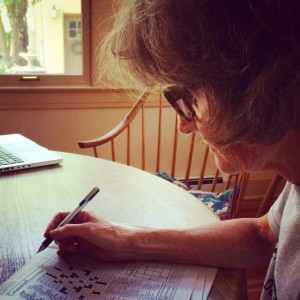Crosswords, Wu-Wei, and Flow

Five letters …Chinese system of thought
Suellen and I like to do crossword puzzles together. We enjoy sorting out the wordplay and ambiguities and finding the solution. When we can’t figure out the answer, we use the same strategy but different tactics.
Our strategy might be called indirection – we move away. I’ve discovered that I often find the answer when I give up. I look at Clue #3 and can’t figure it out. So I think, “Well, I can’t get it so I might as well move on to Clue #4.” In the very brief time that it takes me to move from Clue #3 to Clue #4, the answer often comes to me. I’ve de-focused and given up when the answer simply pops into my head.
Suellen’s indirection is physical and spatial rather than temporal. We typically work at a table and we usually lean in close to the puzzle. When Suellen can’t get the answer, she stands up and looks at the entire puzzle from a distance. She sees the puzzle as a whole and spots patterns. Capturing the global nature of the puzzle helps her sort out specific clues.
In both cases, we move away. We’re no longer trying to solve a specific clue. We’re not doing rather than doing. I thought of this when I read “Trying Not To Try” by Edward Slingerland in a recent issue of Nautilus. Slingerland is a professor of Asian studies and cognition (what a great combo) at the University of British Columbia.
Slingerland describes the Daoist concept of wu-wei or effortless action. “Wu-wei literally translates as ‘no trying’ or ‘no doing’ but it’s not all about dull inaction. In fact, it refers to the dynamic, spontaneous, and unselfconscious state of mind of a person who is optimally active and effective.”
Slingerland argues that achieving wu-wei requires us to balance and integrate Systems 1 and 2. As you may recall, System 1 is our low-energy thinking system that is fast, automatic, effortless, and always on. System 1 makes the great majority of our decisions automatically — we don’t need to think about them. System 2 is the conscious energy hog that helps us think logically and provides executive task control. When we say, “I gave myself permission to have another glass of wine”, we’re essentially saying, “My System 2 gave my System 1 permission…”
Wu-wei integrates the two systems. Slingerland writes, “We have been taught to believe that the best way to achieve our goals is to reason about them carefully and strive consciously to reach them. But [wu-wei] … shows us that many desirable states are best pursued indirectly. … When your conscious mind lets go, your body can take over.”
Wu-wei also reminds me of the concept of flow described by Mihaly Csikszentmihalyi. For instance, Csikszentmihalyi writes that flow involves a stage called incubation, “…during which ideas churn around below the threshold of consciousness.” Similarly, there is an insight phase – an Aha moment. At this stage, too much focus can be self-defeating. You need to let your mind wander. You need to not try too hard.
Whether we call it wu-wei or flow or something else, it’s a remarkable concept. Trying not to try may seem contradictory but it’s worth a try. I find that taking a good long walk can help me get nearly the right balance. My body is occupied and my mind wanders. I’m not trying to do much of anything. That’s when the insights come.